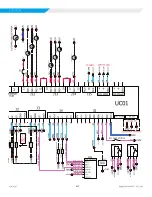
5
IOM 1297
WWW.DAIKINAPPLIED.COM
INSTALLATION
Installation
Operating Limits
Table 1: Operating/Standby Limits
Acceptable Temperatures (WMT)
1
R-1233zd(E)
Condition Component
Description
Min Temp
°F (°C)
Max Temp
°F (°C)
Standby
Evaporator
Water
35 (1.7)
115 (46.1)
Water w/ Anti-
freeze
2
20 (-6.7)
115 (46.1)
Equipment
Room
Air w/ Water in
Vessels
4
40 (4.4)
113 (45)
Air w/ no Water
in Vessels
4
0 (-17.8)
113 (45)
Startup
Evaporator
Water
38 (3.3)
100 (37.8)
Water w/ Anti-
freeze
2
38 (3.3)
100 (37.8)
Condenser
Water
36 (2.2)
111 (43.9)
Equipment
Room
Air
4
40 (4.4)
104 (40)
Operating
Evaporator
Entering Water
38 (3.3)
100 (37.8)
Leaving Water
3
36 (2.2)
80 (26.7)
Entering Water
w/ Antifreeze
2
38 (3.3)
100 (37.8)
Leaving Water
w/ Antifreeze
2,3
36 (2.2)
80 (26.7)
Condenser
Entering Water
40 (4.4)
See Note
1
Leaving Water
3
45 (7.2)
120 (48.9)
Equipment
Room
Air
4
40 (4.4)
104 (40)
NOTES:
1
Contact a Daikin Applied representative for performance
at specific operating conditions, as some limits depend
on unit configuration
2
Antifreeze temperature limits must have appropriate
glycol concentration
3
Allowable leaving fluid temperatures depend on Satura-
tion Temperature
4
5%-95% relative humidity, non-condensing
Nameplates
There are several identification nameplates on the chiller:
•
The unit nameplate is located on the exterior of the Unit
Control Panel. Both the Model No. and Serial No. are
located on the unit nameplate; the Serial No. is unique to
the unit. These numbers should be used to identify the unit
for service, parts, or warranty questions. This plate also lists
the unit refrigerant charge and electrical ratings.
•
Vessel nameplates are located on the evaporator and
condenser. They have a National Board Number (NB) and a
serial number, either of which identify the vessel (but not the
entire unit).
Receiving and Handling
The unit should be inspected immediately after receipt for
possible damage. All Daikin Applied centrifugal water chillers are
shipped FOB factory and all claims for handling and shipping
damage are the responsibility of the consignee.
On units with factory-installed insulation, the insulation is
removed from the vessel lifting hole (also used for transportation
tie-downs) locations and is shipped loose. It should be secured in
place after the unit is finally placed. Neoprene vibration isolation
pads are shipped loose in the power panel. If the unit is equipped
with a shipping skid, leave the skid in place until the unit is in its
final position. This will aid in handling the equipment.
If a knockdown option was ordered on the unit, reference the
Retrofit Knockdown section on page 10 for more information.
Location
WMT chillers are intended only for installation in an indoor or
weather protected area consistent with the NEMA 1 rating on the
chiller, controls, and electrical panels, and not accessible to the
general public. For installation locations in seismic zones greater
than category D, please contact factory.
NOTICE
Indoor installations must be in a structure with a permanent floor
and roof. The unit must be enclosed by walls for protection from
weather conditions.
Excessive humidity in the mechanical room should be avoided. A
limit of 90% non-condensing humidity should be met to minimize
electrical components exposure to water condensing in panels.
Humidity levels in the mechanical room, even if lower than 90%,
can cause water to condense on/near all cool surfaces and
potentially lead to premature component wear. If possible, the
mechanical room should be conditioned which can extend the
useful lifetime for all mechanical room equipment.
Radiant heat from boilers or piping that would adversely raise
component surface temperatures beyond ambient limits must
also be avoided.
DANGER
Prevent lint, paper fibers, dust, metallic chips, or other foreign
material from getting into the inverter or accumulating on VFD
cooling outlets, the heat sink, circuit boards, control panels, or
other electrical devices. Failure to do so may affect operation
of the VFD, void warranty, result in a fire, unit damage, property
damage, severe personal injury, or death. Frequently inspect
area around inverter, heatsink, and other electrical devices to
ensure they are free of foreign material.






































